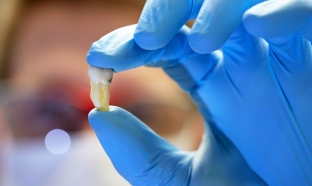Tooth extraction in itself becomes stressful for the patient, however, there are also situations when, after tooth extraction, the hole does not epithelialize, but & nbsp; starts to inflame. Inflammation, or alveolitis, & nbsp; covers the entire gum, accompanied by severe pain, purulent discharge, painful enlargement of the lymph nodes. In severe cases, alveolitis can cause the development of osteomyelitis of the hole. Usually the patient is not able to endure pain for a long time, so advanced cases of alveolitis are rare, and timely treatment promises a favorable prognosis.
Why does the hole become inflamed after tooth extraction
After the extraction of a tooth, blood is released in the formed hole, which coagulates after a few minutes, forming a blood clot. This clot becomes a kind of biological barrier that covers the wound from infection or mechanical damage.
If for some reason the clot has not formed or collapsed due to active rinsing of the oral cavity by the patient, then the walls of the hole may become inflamed due to the penetration of pathogenic bacteria, and then alveolitis develops. Among other reasons why the hole becomes inflamed after tooth extraction, the following can be noted:
- poor oral hygiene, food debris getting into the socket;
- Particles of plaque that fell into the socket during the operation;
- bone fragments remaining in the socket;
- non-removed cysts, granulomas in the socket;
- violation of antisepsis.
The general poor health of the patient due to reduced immunity or exacerbation of some internal or infectious diseases can also become the cause of the development of complications and inflammation after tooth extraction.
Signs of socket inflammation after tooth extraction
Usually, signs of alveolitis begin to appear on the third day after tooth extraction. The patient usually complains of severe pain in the area of the extracted tooth, fever, general weakness and halitosis. The pain radiates to different parts of the head along the course of the nerves, under the lower jaw, the lymph nodes increase and hurt.
On examination, the hole after tooth extraction looks swollen and reddened, covered with a gray coating and purulent discharge. At the bottom of the hole, the remains of a blood clot are visible, a putrid smell is emitted from the hole.
Treatment of alveolitis after tooth extraction
If a patient with suspected alveolitis is not able to arrive for an appointment immediately, he can recommend taking painkillers and rinsing your mouth with a warm solution of baking soda or hydrogen peroxide as often as possible, but do not postpone a visit to the dentist, because inflammation can be complicated by osteomyelitis.

The treatment of alveolitis consists in cleaning the well, treating it with antiseptics, and draining if necessary. The hole is cleared of the remnants of the clot, food particles, fragments of bone tissue, from plaque on the bottom and walls. If necessary, local anesthesia is used before treatment, and after treatment, the well is closed with a turunda with iodoform and anestezin. Such isolation of the hole from the external environment allows you to quickly stop the inflammatory process and eliminate pain.
Together with drug therapy, it is recommended to prescribe physiotherapy in parallel, if necessary, the patient is prescribed analgesics and anti-inflammatory drugs. In the first week, the bandage is changed daily. Usually the pain disappears no later than the third day, the hole begins to fill with granulation tissue on the fifth day. However, it is recommended to isolate the well from the environment for two weeks.
Thus, success in the treatment of an inflamed socket after tooth extraction depends on the properties of the body and on the timeliness of the procedures performed, on the degree of damage to the gums and bone tissue, and on the patient's compliance with the doctor's recommendations.







Add a comment